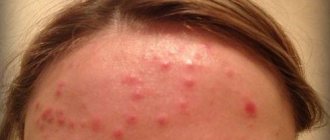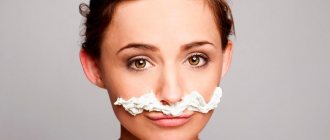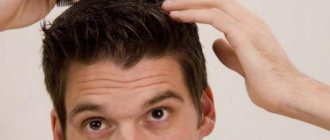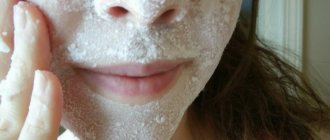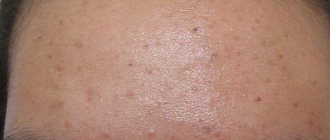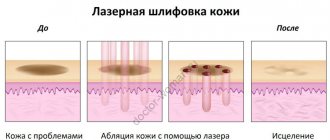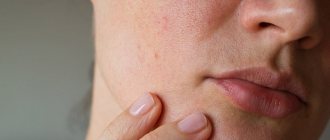Pimples* on the face: causes of occurrence in women104
Women's health and skin condition largely depend on hormonal levels. The male hormone testosterone is responsible for the processes that occur in the epidermis. In women, it is produced by the adrenal glands and ovaries.
With increased secretion of androgens, the sebaceous glands begin to produce too much sebum. Gradually it mixes with particles of dirt, dead cells, cosmetics and undergoes oxidation under the influence of oxygen. This is how open comedones are formed.
Hypersensitivity to steroid hormones in women over 30 years of age is one of the main causes of acne. An increase in androgen activity disrupts the water-lipid balance and causes clogged pores. Gradually, against the background of a slowdown in the process of sebum removal, bacteria begin to multiply in the sebaceous glands, and foci of inflammation appear on the skin.
An active increase in the level of androgens and the tendency to form acne is especially pronounced in the second phase of the menstrual cycle. Before the onset of menstruation, the level of steroid hormones in the body sharply increases, which activate comedogenic processes.
How to get rid of acne on the jaw?
The main way to combat acne is proper hygiene, facial skin care and a healthy diet. To do this, you must use appropriate means. Today, pharmacies have a very wide selection. However, when choosing, you should, if possible, choose drugs with the least amount of preservatives and flavorings.
The main ones are:
- Makeup removers (remove decorative cosmetics and cleanse the skin).
- Tonics for skin renewal and restoration.
- Creams whose main function is to maintain the water-fat balance of the skin, having a cleansing, protective and moisturizing effect.
- Cosmetic masks that ensure the penetration of the active substances they contain, intended for healthy skin.
- Spot preparations (eliminate acne and accelerate the regeneration process).
Important!
In severe cases, drug treatment may be necessary. Treatment is initially based on the use of drugs acting locally, and if they are ineffective, treatment with systemic antibiotics is used.
The most commonly used are tetracycline, doxycycline, etc. Products containing salicylic acid have a good effect. Preparations with anti-inflammatory and antimicrobial effects containing zinc are also useful.
Why do women get acne* on their faces? 104
In adult women, acne is often associated with hormonal diseases of the reproductive system (mastopathy, polycystic ovary syndrome, fibroids, etc.). In some cases, acne is the first indication of the presence of hyperandrogenism. If you have acne on your face, it is important to determine the true reasons for its formation. The fact is that every disease that causes rashes requires specialized, often complex, treatment.
In modern medicine and cosmetology, a number of hormonal factors are identified that lead to the formation of late acne in women:
- Changes in hormonal levels before menstruation. An increase in progesterone levels activates the secretion of sebum, which in turn provokes the formation of premenstrual acne.
- Reception OK. Oral contraceptives contain substances that change the course of the natural processes of hormone production in the female body. In some cases, during use or at the stage of discontinuation of OCs, sebum production is activated, which leads to the formation of acne.
- Endocrine diseases. Dysfunction of the adrenal cortex, pathologies of the pituitary gland and other pathologies of the endocrine system cause excessive acne formation in some women.
- Gynecological diseases. Pathologies of the reproductive system are often a provoking factor in the development of acne in women. In particular, in many patients aged 30-40 years, the appearance of acne is associated with polycystic ovary syndrome.
- Pregnancy. During pregnancy, a woman's body undergoes active hormonal changes, so the appearance of acne during this period is absolutely normal. Especially in the first trimester.
- Menopausal syndrome. Usually observed during the decline of childbearing functions. It is caused by a gradual decrease in the size of the ovaries and uterus, the disappearance of menstrual bleeding. Hormonal changes that occur in the body during menopause often provoke excessive sebum secretion and, as a result, acne.
Home remedies for acne removal
In addition to pharmacological treatment, it is also worth trying home remedies for getting rid of acne. The first of these is enzyme peeling, which acts in the same way as acids (exfoliates dead epidermis), but its effect is much softer and that is why it can be used independently at home.
The second proven way to remove nasty pimples is to apply a little tea tree oil to them. Experts have long proven that the natural substance has strong antibacterial properties and a softening effect. It must be used at night, because it emits a strong, specific odor. After the first use, you can feel a significant difference in the appearance of your facial skin, as well as a reduction in painful acne. It is also important to take a variety of supplements containing zinc, which is very important for the body. Contrary to popular belief, your diet should be enriched with healthy fats, obtained mainly from fish and nuts, as well as plants. Avocado and olive oil are generally recommended.
If acne appears frequently on the jaw, it is best to visit a specialist; he will tell you how to get rid of annoying pimples. In addition, you need to drink eight glasses of water every day - it renews skin cells very well. Include garlic and ginger in your menu, and drink one cup of parsley leaf decoction on an empty stomach. This will significantly refresh the skin and get rid of annoying acne.
Did you like the article? Share it!
What to do if acne occurs?
To get rid of acne, you must first determine the true causes of the pathology. Before performing cosmetic procedures, experts advise visiting a dermatologist, endocrinologist, gastroenterologist and, of course, a gynecologist. Treatment of acne caused by gynecological or endocrine diseases includes eliminating the primary causes of the rash.
To help the body cope with acne faster, cosmetologists recommend reviewing your diet. Changing gastronomic habits (giving up sweets, flour, spicy, salty, etc.) can have a positive effect on the condition of the face.
Hormonal acne is a disease of adulthood
16.08.2021
Acne and acne are considered a teenage problem. However, many adults struggle with pimples and blackheads on the face and other parts of the body. In such cases, so-called hormonal acne . What causes this and what treatments are possible?
Causes of hormonal acne
The most common dermatosis is acne . The disease affects up to 8 in 10 teenagers, but most decline towards the end of puberty. However, there are people who, despite their adulthood, still struggle with painful skin lesions called hormonal acne . This problem affects women more often than men.
The cause of this type of acne is a hormonal imbalance, as a result of which an excess of hormones or, conversely, a deficiency occurs, and hormonal hypersensitivity of some organs is also possible. This problem is related to male hormones or androgens. Violation of their secretion can lead to increased activity of the sebaceous glands, and excess sebum is an excellent breeding ground for Propionibacterium acne bacteria, which are responsible for the occurrence of acne .
The appearance of blackheads and acne can be the result of poor personal hygiene, inadequate nutrition, exposure to chronic stress and improper skin care.
How does hormonal acne manifest?
Typical symptoms of hormonal acne are closed or open papules, pimples , nodules, usually located on the forehead, chin and jawline. These changes can also spread to the skin of the neck , décolleté and back . The resulting pimples are often accompanied by pain and severe inflammation.
Diagnosis of hormonal acne
Hormonal acne is difficult to treat on your own, so the best solution is to discuss it with a dermatologist. Based on anamnestic data and clinical manifestations, a dermatologist can make a preliminary diagnosis. If your doctor suspects that hormonal imbalances may be causing the changes, he will most likely recommend a hormone . Usually the concentration of hormones , such as:
- thyroid hormones (TSH, FT3, FT4);
- prolactin;
- insulin;
- free and total testosterone;
- dehydroepiandrosterone (DHEA);
- luteinizing hormone (LH);
- follicle stimulating hormone (FSH).
Women should be informed that in their case hormonal tests should be carried out on a certain day of the menstrual cycle.
How to care for acne-prone skin?
Unlike juvenile acne , hormonal acne causes milder symptoms but is chronic and therefore more difficult to treat . Treatment must last for at least several months to see its effects.
Depending on the symptoms and their severity, your dermatologist may recommend therapy with benzoyl peroxide or adapalene peroxide creams, ointments, or gels. therapy is often necessary . If the disease is advanced, systemic treatment based on antibiotics and retinoids is introduced.
In addition to pharmacotherapy, it is also important to properly care for skin with acne . It should be cleaned regularly to remove dead skin cells, accumulated dirt and bacteria. A good choice is dermocosmetics designed for sensitive and oily skin, products with exfoliating, antibacterial and antiseborrheic properties. After cleansing, the skin needs to be moisturized. Single lesions can be treated with spot treatments based on tea tree oil and zinc.
To combat acne , you can use herbal infusions of nettle leaf, horsetail, tricolor violet and willow herb with small flowers. These herbs improve metabolic processes and regulate sebum secretion.
Published in Dermatology Premium Clinic
Acne on the face: causes and treatment
There are many reasons for the occurrence of acne: the use of cosmetics with comedogenic ingredients, stress, genetic predisposition, taking medications (for example, anabolic steroids), gastrointestinal pathologies, etc.31,49,80. When prescribing treatment, the dermatologist also takes into account why the rash appeared. In the treatment of mild to moderate acne, azelaic acid, for example, Azelik®5,9, can be used. The drug is used twice a day5. It is applied to clean, dry skin5.
*acne
Rash on neck
A rash on the neck is primarily a signal of a malfunction of internal organs or pathologies, and not just an aesthetic problem. There is a wide range of reasons, and only a doctor can name the exact one after examination and tests.
According to statistics, people encounter the problem of a rash on the neck no less often than on the back or any other place, but do not pay enough attention to it. Before buying expensive drugs, we strongly recommend visiting a doctor who can establish an accurate diagnosis, otherwise you are more likely to harm your body. Below, you can familiarize yourself with the main reasons that cause a rash on the neck in adults:
- Problems with human hormonal levels. For example, in adolescents, red rashes on the face signal the process of restructuring taking place in the body from childhood to adulthood. In this case, such a rash is normal, but drugs that eliminate it are still used for aesthetic purposes. It is also considered normal to have red spots on the face during the menstrual period and in pregnant women. As for rashes in other people associated with changes in hormones, this is a definite failure. It is imperative to deal with it, since such problems can negatively affect all processes of human life. Hormone tests are used for diagnosis, which will confirm or refute problems associated with hormonal levels. It should be noted that rashes of the first type, associated with changes in the body, and those that occur due to hormonal imbalance, differ from each other. Age-related red rashes resemble blisters or acne in other words, they are bright in color, rich, inflamed and watery. As for spots in pregnant women and with women's problems, they are more like the allergic nature of the rash. In addition, there are many other types of redness due to hormonal changes in the body.
- Vitamin deficiency is another reason why there may be protrusion of red spots on the face and body. In this case, a lack of vitamins weakens the immune system, and redness of various types appears as a protective reaction. In order to determine which vitamin is missing in the body, you should undergo a certain examination.
- Allergy. Here we can note the most common irritant that causes a rash on the neck - vitamin D. That is, a reaction to the sun. It is not uncommon for food to be an irritant, especially citrus fruits and various fruits. But other factors should not be excluded: animals, alcohol, clothing materials and much more.
- Bad habits, in particular smoking. In addition to the fact that they weaken the immune system, a rash on the neck may be the body’s reaction to tobacco, or more precisely to the nicotine it contains.
- Severe stress. Due to a malfunction of the nervous system, a person develops red spots on the body, in particular on the neck. Typically, this occurs after a strong shock or due to a stable state of stress.
- Side effects of medications. When taking new medications, redness of the neck is a very common reaction.
- Strong changes in body temperature. Due to hypothermia or, conversely, overheating, red spots form on the skin, and after a short time they disappear.
- Poor quality cosmetics. Often, hazardous substances may be added to products; be especially careful with counterfeits of expensive brands.
- Pathologies and diseases of internal organs. The most common case is problems with the thyroid gland. But identifying the exact epicenter of the disease and its nature will only be possible through examination and testing.
- Problems with the reproductive organs. This problem can occur in both men and women.
- Prickly heat. This disease is associated with poor hygiene and, as a result, infection in the body. In the absence of timely treatment, red spots may not be a problem. It is necessary to immediately contact a specialist to avoid complications and spread of the disease.
- Syphilis. Redness in the neck area usually appears six months after infection. They can have different sizes and color intensity. Over time, they will cover the patient's entire neck. Before obvious redness appears, areas of the skin begin to darken. In the first stages of syphilis, small pimples appear throughout the body. Which disappear and appear again at different intervals. At the stage of redness of the neck, hair begins to fall out and most internal organs malfunction. This disease can only be treated with the help of an experienced specialist.
As you can understand, there are a huge number of reasons that cause a rash in an adult, and only a specialist can determine the exact cause, who will prescribe the most effective treatment.
Causes of the rash
Skin rashes can be caused by a number of different reasons: infections, allergic reactions, autoimmune diseases, exposure to heat, sunlight.
Causes of the rash include:
- atopic dermatitis (eczema);
- contact dermatitis;
- urticaria (caused by an allergic reaction to food or medication, infection, stress, contact with animals, chemicals, exposure to sunlight, cold, etc.);
- infectious diseases of viral, bacterial, fungal nature (measles, rubella, chickenpox, scarlet fever, hand-foot-mouth syndrome, molluscum contagiosum, lichen rosea, ringworm, seborrheic dermatitis, erythema infectiosum, herpes zoster, bacterial tonsillopharyngitis, impetigo, multisystem inflammatory syndrome in children associated with COVID-19);
- acarodermatitis (parasitic disease, scabies);
- rosacea;
- lichen planus;
- autoimmune diseases (psoriasis, systemic lupus erythematosus, dermatomyositis);
- malignant diseases of the mammary glands in women (inflammatory breast cancer, Paget's cancer, etc.);
- acne;
- acne of newborns (neonatal pustulosis);
- toxic erythema of newborns;
- diaper dermatitis;
- prickly heat;
- insect bites;
- taking medications (allergy to amoxicillin, Stevens-Johnson syndrome, erythema multiforme exudative);
- angioedema (Quincke's edema).

